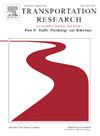Transition toward driverless robotaxi: Role of social anxiety, perceived safety, and travel habit
IF 3.5
2区 工程技术
Q1 PSYCHOLOGY, APPLIED
Transportation Research Part F-Traffic Psychology and Behaviour
Pub Date : 2025-02-01
DOI:10.1016/j.trf.2025.01.031
引用次数: 0
Abstract
Robotaxi services integrate autonomous driving technology with traditional online ride-hailing and can meet the increasing demand for urban transportation. This study analyzed the factors influencing passengers’ intentions to transition from traditional ride-hailing to robotaxi services. Using the stimulus-organism-response framework and theory of planned behavior, we examined social anxiety (social environment anxiety, social performance concern, and stranger interaction avoidance) and technological factors (perceived technical safety and perceived operational safety) as external stimuli affecting individuals’ internal states and behaviors. Data from 510 valid questionnaires collected in China’s first-tier cities (Beijing, Shanghai, Guangzhou, and Shenzhen) revealed that social anxiety and perceived safety significantly affected transition intentions. Among the social anxiety variables, social environment anxiety had the strongest influence, followed by social performance concerns and stranger interaction avoidance. Additionally, travel habits emerged as a significant moderator between subjective norms and transition intentions and between perceived behavioral control and both transition intentions and behaviors. The classification of user groups based on levels of social anxiety and travel habits provided valuable insights; for instance, passengers with high social anxiety and weak travel habits were more inclined to transition to robotaxi services. These findings offer practical implications for urban planners and robotaxi service providers to address transportation challenges in rapidly urbanizing areas.
求助全文
约1分钟内获得全文
求助全文
来源期刊
CiteScore
7.60
自引率
14.60%
发文量
239
审稿时长
71 days
期刊介绍:
Transportation Research Part F: Traffic Psychology and Behaviour focuses on the behavioural and psychological aspects of traffic and transport. The aim of the journal is to enhance theory development, improve the quality of empirical studies and to stimulate the application of research findings in practice. TRF provides a focus and a means of communication for the considerable amount of research activities that are now being carried out in this field. The journal provides a forum for transportation researchers, psychologists, ergonomists, engineers and policy-makers with an interest in traffic and transport psychology.

 求助内容:
求助内容: 应助结果提醒方式:
应助结果提醒方式:


